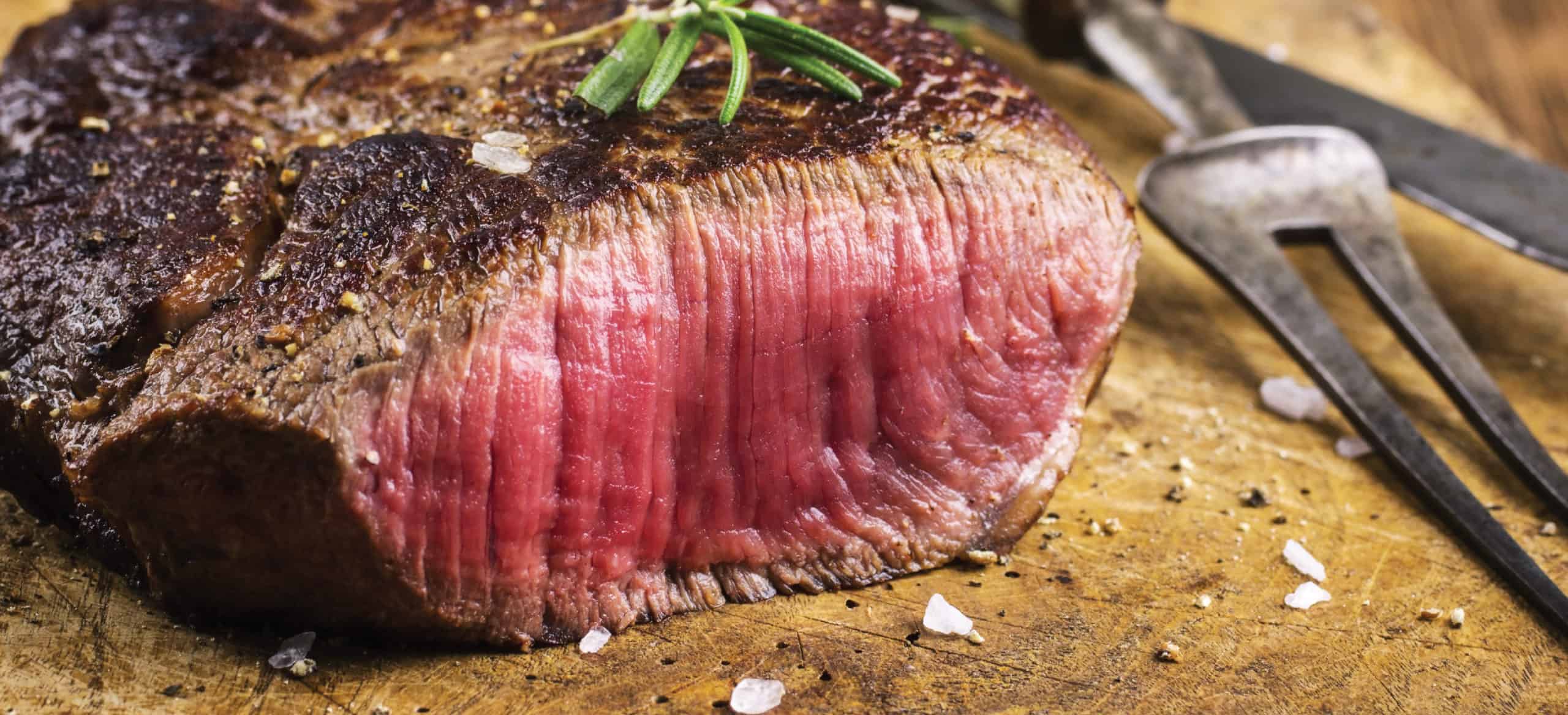There’s a lot of conflicting information out there when it comes to red meat.
It seems like every other week, several new red meat studies emerge, often landing on opposite sides of the spectrum when it comes to the health effects of this controversial ingredient.
While some believe that beef, pork, and venison are loaded with nutrients and health benefits, others claim that they can contribute to cancer, heart disease, and a slew of other health problems.
So is chicken red meat? Is duck red meat? And is bacon also? This article will take a closer look at which foods are categorized as red meat, along with a few of the potential benefits and disadvantages.
What Is Red Meat?
Red meat is commonly defined as the meat of mammals. Unlike fish or poultry, it typically has a bright red color when raw and tends to darken when cooked.
Technically, it can also be classified as any type of meat that has more myoglobin than white meat, which is the non-dark meat found in chicken or fish.
Myoglobin is a type of protein found in the muscle tissue that carries and stores oxygen.
So what is considered red meat? It’s not always black and white when it comes to differentiating between white and red meat animals.
While beef, elk, and venison are almost always classified as red meat, other types of meat like pork or veal are often considered white flesh under the culinary definition due to their lighter hue.
However, according to the USDA, all mammals are considered a red meat, regardless of the cut or age.
Types/Varieties
So is pork red meat, and is the lamb also? Although some types of meat are classified as white meat under the culinary definition, the flesh of any mammals is technically considered red meat.
Here are some of the most common ingredients on the red meat list:
- Beef
- Lamb
- Pork
- Veal
- Venison
- Goat
- Mutton
- Rabbit
- Boar
- Buffalo
- Horse meat
- Rabbit
- Hare
- Elk
- Bison
Nutrition Facts
One of the main benefits of eating meat is the array of nutrients that it provides.
Although the exact nutrition profile can vary based on the type, cut, and cooking method of the meat, most varieties are wide in protein and micronutrients like zinc, vitamin B12, and selenium.
A three-ounce serving of ground beef contains the following nutrients:
- 182 calories
- 0 grams carbohydrate
- 22.5 grams of protein
- 9.5 grams of fat
- 5.7 milligrams zinc (38 percent DV)
- 2.1 micrograms vitamin B12 (35 percent DV)
- 18.4 micrograms selenium (26 percent DV)
- 4.4 milligrams niacin (22 percent DV)
- 164 milligrams phosphorus (16 percent DV)
- 0.3 milligrams vitamin B6 (15 percent DV)
- 2.5 milligrams iron (14 percent DV)
- 0.1 milligrams riboflavin (9 percent DV)
- 255 milligrams potassium (7 percent DV)
In addition to the nutrients listed above, ground beef also contains magnesium, pantothenic acid, copper, and vitamin E.
Meanwhile, grass-fed beef is considered to be far healthier than conventionally raised, factory-farmed meat. This beef comes from cattle that eat only grass and other foraged foods during their lives.
What a cow consumes directly affects the types and levels of nutrients and fats you get from eating meat from that cow.
For example, grass-fed beef nutrition includes significantly more omega-3 fatty acids and more conjugated linoleic acid (CLA) than grain-fed beef.
Risks
Within the past few years, a slew of studies has emerged, calling the potential health effects of meat into question. So why is red meat wrong for you?
For starters, it’s very high in saturated fat. Although studies show that there is no direct link between saturated fat consumption and heart disease, it could increase levels of bad LDL cholesterol in the blood, which can contribute to the build-up of fatty plaque in the arteries.
Some evidence suggests that red meat consumption could also be tied to a higher risk of heart problems.
For example, one study out of Boston showed that eating higher amounts of it was linked to a higher risk of heart failure among male physicians.
Another study found that increased red and processed meat consumption was associated with a higher risk of dying from heart disease and cancer.
That being said, it’s important to distinguish between processed and unprocessed meat when evaluating the potential effects on health.
In a large study in over 448,000 people, for instance, processed meat was tied to a higher risk of mortality, primarily due to heart disease. In contrast, unprocessed red meat showed no association.
Several studies have also found a link between red meat and cancer.
In fact, in 2015, the World Health Organization classified red meat as “probably carcinogenic to humans,” noting that there is some evidence showing a possible association between red meat consumption and colorectal, pancreatic, and prostate cancer.
However, it’s essential to keep in mind that many of these studies lump red and processed meat together, which could potentially skew the results.
In a 2015 study in PLoS One, researchers evaluated the diets of over 134,000 people to determine how red meat consumption could impact the risk of developing cancer.
According to the study, while processed meat was associated with an increased risk of colorectal cancer, there was “little evidence that higher intake of unprocessed red meat substantially increased risk of colorectal cancer.”
Some research suggests that other factors could be at play as well, including the way that the meat is cooked and prepared.
Cooking meat and other foods at high temperatures can increase the production of harmful compounds like advanced glycation end products (AGEs), heterocyclic amines (HAs), and polycyclic aromatic hydrocarbons (PAHs), all of which can contribute to cancer development.
Minimizing exposure to high heat by using cooking methods like stewing or steaming can help decrease the formation of these harmful chemicals.
Although uncommon, some people also have a red meat allergy, also known as an alpha-gal allergy.
For those with an allergy, eating meat can trigger side effects like nausea, itching, or vomiting. If you experience any of these symptoms after consumption, discontinue use immediately and consult with your doctor.
Health Benefits
In moderation, red meat can be a nutritious addition to a well-rounded diet.
It’s a great source of many nutrients and can help boost your intake of crucial vitamins and minerals, including zinc, vitamin B12, selenium, and niacin.
These micronutrients play a central role in overall health. Zinc, for example, is essential for immune health and can help defend the body against illness and infection.
Meanwhile, the B vitamins found in red meat are involved in energy production, brain function, and cell repair.
Meat is also one of the best food sources of iron, an essential mineral that is necessary for the production of healthy red blood cells.
A deficiency in this vital nutrient can cause anemia, a condition characterized by symptoms like weakness, fatigue, brittle nails, and shortness of breath.
Plus, meat is a high-protein food. Protein is an essential nutrient that can support healthy growth and development, maintain immune function, enhance muscle growth, and more.
Studies show that protein may also aid in weight management as well. Eating more protein may help reduce levels of ghrelin, the hormone responsible for stimulating feelings of hunger.
According to a trial in the American Journal of Clinical Nutrition, following a high-protein diet for 12 weeks also led to significant reductions in appetite, caloric intake, and body weight.
How to Prepare
Despite the potential health risks, this flavorful ingredient can still be enjoyed in moderation as part of a healthy diet.
Be sure to select unprocessed cuts of lean red meat whenever possible and keep your consumption of processed products like hot dogs, bacon, and sausage to a minimum.
Switching up your cooking method can also help reduce potential health risks.
Instead of cooking meat at high temperatures, try steaming or stewing chickens to prevent the formation of harmful compounds like AGEs and heterocyclic amines.
Avoid eating meat that is charred, smoked, or burnt, as it may be more likely to contain carcinogenic compounds.
Marinating meat in lemon juice, garlic, or red wine before cooking is another strategy that can also help prevent the formation of these harmful chemicals.
Keeping meat consumption in moderation and avoiding unhealthy fad diets like the carnivore diet is also crucial. The American Institute for Cancer Research recommends limiting red meat intake to just three servings per week.
For a simple solution to help scale back, try alternating meat with other protein sources in your diet, such as free-range poultry, wild-caught fish, and plant-based protein foods.
Here are a few delicious and nutritious recipes that feature red meat:
Final Thoughts
- What is red meat? This meat is defined as the meat of mammals, which includes beef, pork, veal, venison, elk, bison, and buffalo.
- Is red meat rotten for you? Some observational studies have found that regular consumption could be associated with a higher risk of heart disease and certain types of cancer, but more research is still needed.
- On the other hand, meat offers a wealth of nutrients that are important to health, including protein, zinc, iron, vitamin B12, and selenium.
- Limiting meat consumption to just a few servings per week, marinating meat, and using gentler cooking methods like steaming or stewing can ensure that you’re still able to enjoy this flavorful ingredient as part of a healthy diet.








